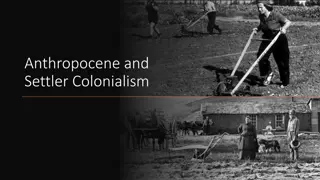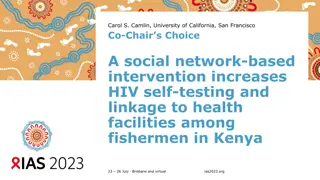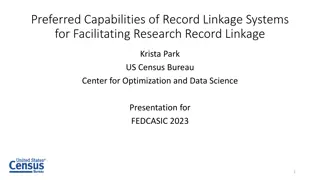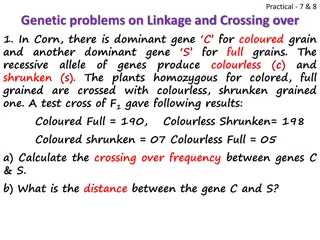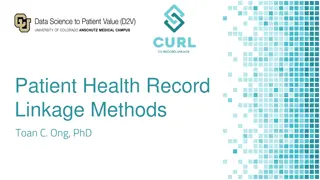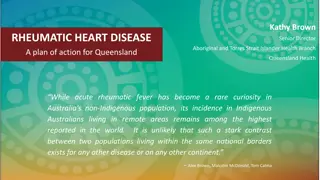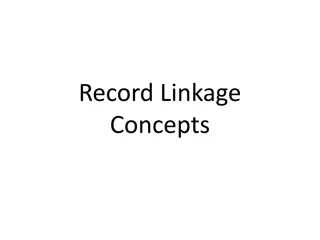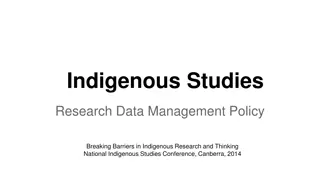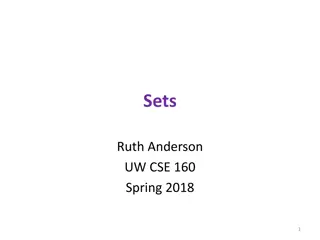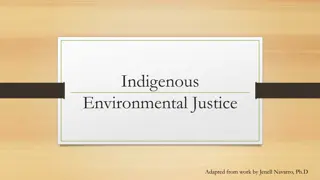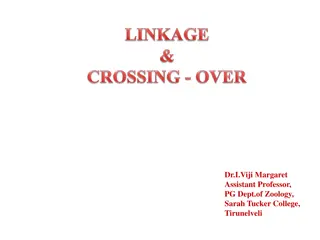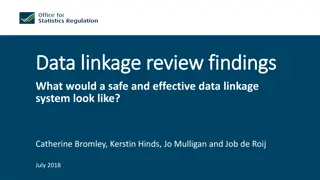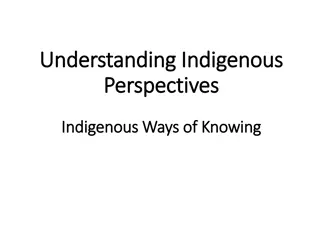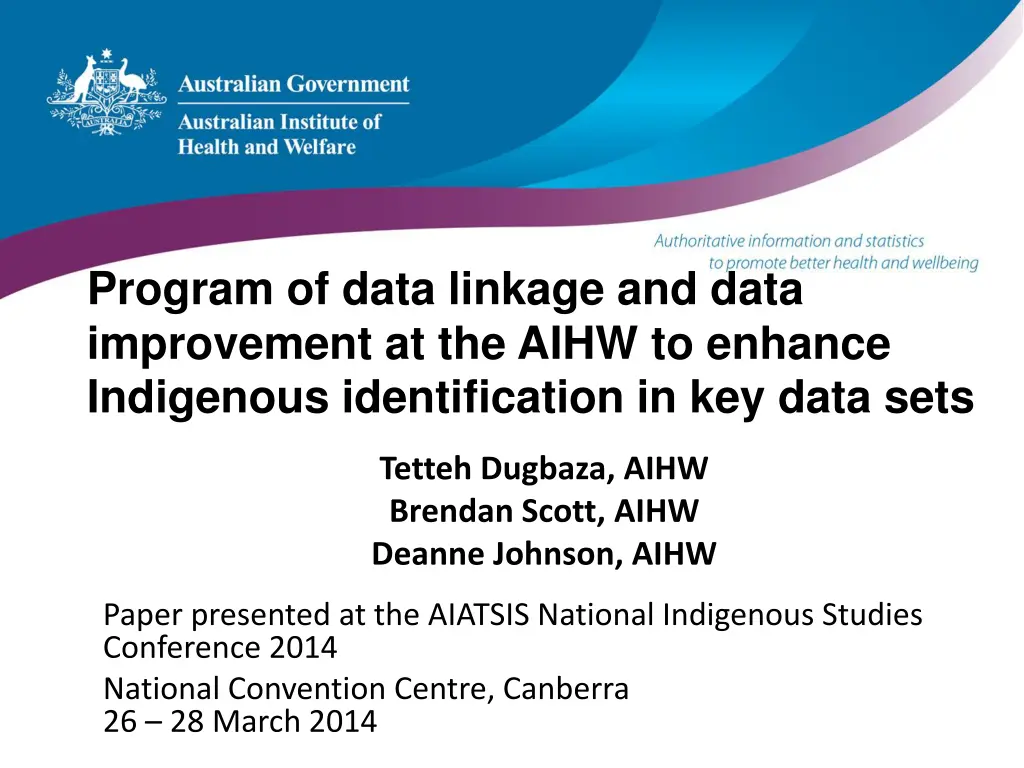
Improving Indigenous Data Linkage for Policy Development
Enhance Indigenous identification in key data sets through data linkage and improvement initiatives at AIHW. Learn about national best practices, guidelines, and issues in linking data for Aboriginal and Torres Strait Islander people.
Download Presentation

Please find below an Image/Link to download the presentation.
The content on the website is provided AS IS for your information and personal use only. It may not be sold, licensed, or shared on other websites without obtaining consent from the author. If you encounter any issues during the download, it is possible that the publisher has removed the file from their server.
You are allowed to download the files provided on this website for personal or commercial use, subject to the condition that they are used lawfully. All files are the property of their respective owners.
The content on the website is provided AS IS for your information and personal use only. It may not be sold, licensed, or shared on other websites without obtaining consent from the author.
E N D
Presentation Transcript
Program of data linkage and data improvement at the AIHW to enhance Indigenous identification in key data sets Tetteh Dugbaza, AIHW Brendan Scott, AIHW Deanne Johnson, AIHW Paper presented at the AIATSIS National Indigenous Studies Conference 2014 National Convention Centre, Canberra 26 28 March 2014
Selected program of work National best practice guidelines for data linkage activities relating to Aboriginal and Torres Strait Islander people Enhanced Mortality Database project Linked perinatal, birth, death data set project 2
National Best Practice Guidelines for Data Linkage Activities Relating to Aboriginal and Torres Strait Islander People Background Accurate data about Indigenous people are needed to guide policy formulation, program development and service delivery, towards closing the gap in disadvantage. Progress is difficult to measure accurately because many Indigenous people are not consistently identified in key data sets. Data linkage offers a cost-effective approach to enhancing the completeness and consistency of Indigenous status information on key data sets. There are no nationally agreed approaches on how to deal with missing or inconsistent Indigenous status reporting across data sets. This leads to different methods being used, and difficulties in interpreting findings, when comparing results across studies. 3
National Best Practice Guidelines for Data Linkage Activities Objective To ensure that a consistent and informed program of data linkage work is carried out across Australia, the Council of Australian Governments, as part of addressing the problem of Indigenous data gaps, tasked the Australian Institute of Health and Welfare and the ABS to develop national best practice guidelines for linking data relating to Indigenous people. 4
National Best Practice Guidelines for Data Linkage Activities Issues to consider when choosing a method the purpose of the study the characteristics of the data sets involved the linkage approach used in the study the number of data sets involved in the study characteristics of the data sets involved in the study the quality of the linkage variables the quality of the linkage process in terms of the proportion of missed and false links in the linked data set. 5
National Best Practice Guidelines for Data Linkage Activities Simple algorithms Ever-Indigenous Frequency-based methods Indigenous in more than one data set Indigenous in at least a majority of data sets Single source methods The most trusted data set Complex algorithms The current or most recent Indigenous status Within and across data sets approach Weighted data set approach 6
Enhanced Mortality Database Project Background Current estimates of Indigenous mortality suffer from: imperfect identification of Indigenous deaths in the death notification collection changes in coverage in the estimates of the Indigenous population. As a result, the true levels, patterns and trends of the mortality of Indigenous Australians cannot be reliably measured. While estimates of the size of the Indigenous population have improved through better population census counts, improvements in Indigenous identification in death data have been slow. 7
Enhanced Mortality Database Project Objectives To improve information on Indigenous status on the registered deaths data set by linking it to several additional data sources that contain information on Indigenous deaths and Indigenous identification. The enhanced death data are expected to enable more accurate estimates of Indigenous mortality, including life expectancy, to be made To maintain an ongoing researchable linked database to support research in Indigenous mortality and life expectancy 8
Data sets National Death Index (NDI) National Hospital Morbidity Database National Perinatal Data Collection Residential Aged Care Data set 9
Enhanced Mortality Database Project - Methods Use of probabilistic and deterministic data linkage methods to link the registered deaths data set with additional data sets Creation of an enhanced mortality data set containing enhanced Indigenous status information Ever-identified method used in deriving enhanced Indigenous status Alternative algorithms to be used in subsequent phases of the project Development of Indigenous life tables based on the enhanced mortality data set. 10
Phases of EMD Project Phases 1-2: 2001-2006 Feasibility study State and territory estimates Yearly estimates Phase 3 Feasibility of using NTSCORP Research Database to validate results of Phases 1-2 Phase 4 2007-2011 Use of additional algorithms Feasibility of using additional data sets Validation of results for NSW using NTSCORP Research Database 11
Additional Indigenous deaths identified through linkage Added records as a % of original Indigenous deaths In original deaths data (NDI) State/ territory NSW Vic Qld WA SA Tas. ACT NT Australia 7/05/2025 Added records in NDI 2,464 368 2,780 1,885 700 112 409 155 252 132 55 56 17 42 9 7 8 50 65 4 6 1 2,200 10,574 18 1,081 10 12
Additional Indigenous deaths identified through linkage Males Females Total in NDI 430 233 1,771 1,980 1,654 6,068 Total in NDI 301 138 934 1,405 1,728 4,506 % of NDI 10 % of NDI 16 No. No. added added Age 0-4 5 19 20 44 45 64 65+ All ages 7/05/2025 41 13 49 117 312 532 48 3 43 109 346 549 6 3 6 2 5 8 19 9 20 12 13
Coverage rate of Indigenous deaths in NDI: Results from Enhanced Mortality Database 100 Males 95 Females Coverage rate (%) 90 85 80 75 0-4 5-19 20-44 45-64 65+ Age 7/05/2025 14
Linked Perinatal, Birth, Death Data Set Project Background Babies born to Indigenous mothers display worse health outcomes than babies born to non-Indigenous mothers. e.g. In 2012, 13.5% of babies born to Indigenous mothers were preterm (before 37 completed weeks of gestation) compared with 8.0% of babies born to non-Indigenous mothers In 2012, 12.0% of babies born to Indigenous mothers were of low birth weight (<2500 grams), twice that of babies born to non- Indigenous mothers (6.0%). In 2010, the neonatal mortality rate was 6.9 per 1,000 babies born to Indigenous mothers compared with a rate of 2.7 per 1,000 babies born to non-Indigenous mothers. In 2012, the infant mortality rate for Indigenous babies was 6.4 per 1,000 live births, compared with 3.3 for non-Indigenous babies. 15
Linked Perinatal, Birth, Death Data Set Project Background continued The risk factors for these poor birth outcomes are known to cut across demographic, health, lifestyle, social, environmental and contextual domains. Research into the simultaneous effect of these factors has however been hampered by the lack of a national linked perinatal, births, and deaths data set that contains relevant information across these domains. 16
Linked Perinatal, Birth, Death Data Set Project Objectives To create a national linked perinatal, data set containing information that will enable AIHW researchers to answer some key questions pertaining to differentials in birth and health outcomes, between Indigenous and non- Indigenous Australians. 17
Linked Perinatal, Birth, Death Data Set Project Benefits The study will help AIHW researchers to understand the complex relationship between the risk of child death on the one hand, and maternal characteristics, antenatal factors, labour and birth characteristics, and contextual factors, on the other This understanding will help policy makers develop policies and programs to address adverse infant and child health outcomes. There are currently no national sources that can describe the broader measures of child health and well-being other than by linking perinatal, births and deaths data, at the national level. The project will help enhance Indigenous status information, where Indigenous status is missing or is inconsistently reported across the three data sets 18
Linked Perinatal, Birth, Death Data Set Project Data sets Registered births data set Registered deaths data set (held by the AIHW in the form of the National Death Index) Perinatal Data set Scope Babies born in Australia between 2003 and 2010 Deaths occurring to this cohort of babies from birth to age 5 years, of between 2003 and 2015. 19
Linked Perinatal, Birth, Death Data Set Project Methods Data linkage to create the Linked Perinatal Data Set Demographic and statistical modelling to examine the relationship between: maternal contextual factors, maternal health characteristics, maternal socio-economic characteristics and Indigenous status, on the one hand, and birth outcomes on the other Indigenous status and birth outcomes on the one hand, and the risk of child death, on the other 20
Links to reports featured in this presentation Enhanced mortality database for estimating Indigenous life expectancy http://www.aihw.gov.au/publication-detail/?id=10737422286 National best practice guidelines for data linkage activities relating to Aboriginal and Torres Strait Islander people http://www.aihw.gov.au/publication-detail/?id=10737422216 For further information, please contact: Tetteh Dugbaza - 02 6244 1108 Brendan Scott - 02 6244 1248 21



